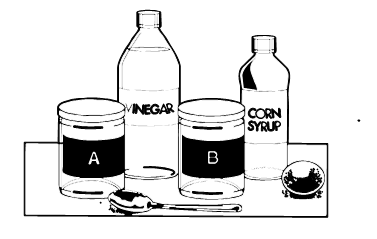Observing Osmosis

It is difficult to see osmosis occurring in cells because of the small size of the cell. However, there are a few cells that can be seen without the aid of a microscope. Try this activity to see how osmosis occurs in a large cell.
Problem: How does osmosis occur in an egg cell?
Materials
- Raw egg
- 500 ml beaker
- 250 ml vinegar
- 250 ml corn syrup
- 250 or larger graduated cylinder
- parafilm (or saran wrap)
- water
Day 1
____ Place the egg into the 500 ml beaker. Pour 250 ml of vinegar over the egg. Cover the beaker
____ After 30 minutes, record your observations in the data table
____ Let stand for two days
Day 2
____ Record the appearance of the egg in the data table.
____ Carefully pour the vinegar into a graduated cylinder, record the amount you now have in the data table.
____ Rinse the egg off and pour 250 ml of the corn syrup over the egg and cover. Let stand for two days.
Day 5
____ Record the appearance of the egg in the data table.
____ Carefully pour the corn syrup into a graduated cylinder. Record the amount in the data table.
____ Rinse off the egg and pour 250 ml of water over the egg. Cover and let stand for two days.
Day 7
____ Record the appearance of the egg in the data table
____ Carefully pour the water into a graduated cylinder and record the amount in the data table.
____ Dispose of your egg.
Data Table
| Record the amount of liquid in the beaker in ml | Observations | |
| Day 1 | ||
| Day 3 | ||
| Day 5 | ||
| Day 7 |
Analysis
1. Describe what happened to the egg after it soaked in vinegar.
2. Describe what happened to the egg after it soaked in corn syrup.
3. How does OSMOSIS explain these observations.
Other Resources on Osmosis
Observe Diffusion in a Bag – model diffusion using a plastic baggie, iodine and a beaker. This article explains what happens.
Story Lab – How Can Diffusion be Observed – based on the “diffusion in a bag” lab where students read a passage about diffusion
Investigation: The Effect of Salt on a Potato – simple lab where a potato is soaked in salt water.
Cell Membrane and Transport Coloring – shows the phospholipid bilayer and different types of transport